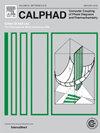Na2O-SiO2体系的临界评价与热力学再评价
IF 1.9
3区 材料科学
Q4 CHEMISTRY, PHYSICAL
Calphad-computer Coupling of Phase Diagrams and Thermochemistry
Pub Date : 2024-12-27
DOI:10.1016/j.calphad.2024.102791
引用次数: 0
摘要
Na2O-SiO2 系统的热力学研究对于硅酸盐玻璃工业和控制高炉输入材料中的 Na2O 平衡极为重要。以往的研究已对 Na2O-SiO2 体系进行过多次热力学评估。然而,对富含 Na2O 一侧的相平衡描述仍然不够充分。因此,本研究采用 CALPHAD 方法对 Na2O-SiO2 体系进行了重新评估。液相采用双子晶格部分离子液体模型 (Na+1)P(O-2,SiO4-4,SiO2)Q 进行描述,由于六种中间化合物的固溶解度有限,因此将其作为化学计量化合物处理。计算得到了一组自洽的热力学参数,实验相图数据和热力学性质在实验误差范围内得到了令人满意的再现。本热力学参数有助于硅酸盐玻璃的成分设计和高炉输入材料的配方。本文章由计算机程序翻译,如有差异,请以英文原文为准。
Critical evaluation and thermodynamic reassessment of the Na2O-SiO2 system
Thermodynamic investigation of the Na2O-SiO2 system is extremely significant for the silicate glass industry and the control of Na2O balance in the input materials of blast furnaces. The Na2O-SiO2 system has been thermodynamically assessed numerous times in the previous studies. However, the phase equilibria in the Na2O-rich side remain inadequately described. Consequently, the Na2O-SiO2 system was reassessed by the CALPHAD approach in the present work. The liquid phase was described by using the two-sublattice partially ionic liquid model (Na+1)P(O−2,SiO4−4,SiO2)Q and six intermediate compounds were treated as stoichiometric compounds due to their limited solid solubilities. A set of self-consistent thermodynamic parameters was then obtained, and the experimental phase diagram data and thermodynamic properties can be satisfactorily reproduced by the calculation within the experimental errors. The present thermodynamic parameters contribute to the composition design of silicate glass and the formulation of input materials in blast furnaces.
求助全文
通过发布文献求助,成功后即可免费获取论文全文。
去求助
来源期刊
CiteScore
4.00
自引率
16.70%
发文量
94
审稿时长
2.5 months
期刊介绍:
The design of industrial processes requires reliable thermodynamic data. CALPHAD (Computer Coupling of Phase Diagrams and Thermochemistry) aims to promote computational thermodynamics through development of models to represent thermodynamic properties for various phases which permit prediction of properties of multicomponent systems from those of binary and ternary subsystems, critical assessment of data and their incorporation into self-consistent databases, development of software to optimize and derive thermodynamic parameters and the development and use of databanks for calculations to improve understanding of various industrial and technological processes. This work is disseminated through the CALPHAD journal and its annual conference.

 求助内容:
求助内容: 应助结果提醒方式:
应助结果提醒方式:


